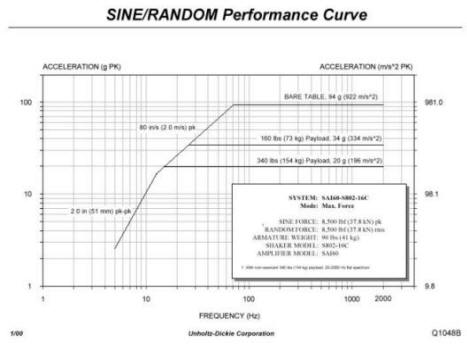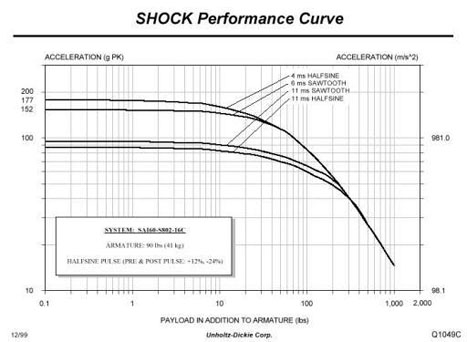System Force Rating
Electrodynamic vibration test systems are used to satisfy a wide variety of vibration test requirements. Sine, random, and shock testing are considered the three basic test environments and are reflected in the standard ratings for all Unholtz-Dickie vibration test systems. All vibration test systems are rated in “peak force” for sine and shock, and in “rms force” for random.
In comparing UD shaker systems with other manufacturer's systems, it is vitally important to investigate more than equivalent overall force rating. Carefully check the individual sine, random and shock rating curves to ensure the selected system will meet the overall desired performance.
Sine Ratings
 The vast majority of all industry standard sinusoidal vibration test specifications are within the 5 - 2,000 Hz frequency range. All UD systems are rated for full performance within this range.
The vast majority of all industry standard sinusoidal vibration test specifications are within the 5 - 2,000 Hz frequency range. All UD systems are rated for full performance within this range.
In addition, all UD systems can be operated at lower and higher frequencies but typically at reduced ratings. Some highly specialized UD systems are fully rated below 5 Hz and above 2,000 Hz.
Sine performance is defined by an envelope of maximum displacement, velocity, and acceleration as a function of frequency for a given amplifier/shaker and test load weight combination. The sine performance is bounded by the system maximum displacement at low frequencies (typically two inches), maximum velocity at mid-band frequencies (typically 70-80 in/sec) and maximum acceleration (for various product load weights) at the high frequencies.
Random Ratings
The vast majority of all industry standard random vibration test specifications are within the 2,000 Hz frequency range. Random testing performance depends greatly on the selected power spectral density (PSD) shape, frequency range, amplitude and test load weight and test load structural characteristics. There are an infinite number of such combinations.
To ensure uniformity, UD utilizes a common set of test conditions. These include a flat power spectral density (g2/Hz) from 20 to 2,000 Hz and a heavy, non-resonant load (typically 3 to 4x armature weight). All UD systems can be operated at lower and higher frequencies and with non-flat PSD but typically at reduced ratings.
Other shaker manufacturers sometimes use the less demanding ISO 5344 PSD shape for random rating, which is flat from 100 to 2,000 Hz but rolls off sharply below 100 Hz to 20 Hz. The UD random rating technique provides consistency and ensures high overall system performance.
Shock Ratings
 Shock testing utilizing electrodynamic shaker systems in place of drop testers and hydraulic shakers, offers the benefits of:
Shock testing utilizing electrodynamic shaker systems in place of drop testers and hydraulic shakers, offers the benefits of:
- excellent accuracy
- repeatability
- convenienceof common test fixtures
The higher displacements and velocities available with UD's newer model electrodynamic shaker systems permit even a wider range of shock pulses.
The Shock performance is dependent on many different variables including pulse shape (half-sine, trapezoid, sawtooth, etc.), pulse peak amplitude, pulse duration, test load weight and load dynamics. The pulse shape, amplitude and duration parameters actually determine the velocity and displacement requirements for the specified pulse.
There are an infinite number of shock pulse shapes. However, half-sine and sawtooth shapes are very common examples. UD shaker systems are typically rated with these common pulses and are graphed in terms of peak acceleration amplitude vs. test load weight. It is quite simple to determine shock system test capability from these curves. Note that higher peak amplitudes are achievable with sawtooth vs. half-sine pulses and higher amplitudes are generally achievable for narrow pulses with light loads.
Some other manufacturers offer very misleading or very limited shock performance information. Often, this is defined as a crude force number of 3x random force rating or 2x sine force rating. This general statement may theoretically be valid for some very limited shock transient pulses, but it is totally inadequate because it does not take into consideration the shock pulse shape or duration. The shock rating of 3x random rating is a gross oversimplification derived from generating 3 sigma peaks (3x rms) in a random test. Furthermore, the crude force number (3x random rating) often refers to a theoretical “shaker” limit only, but not the specific amplifier/shaker system combination. Some manufacturers require an optional matching transformer to achieve even moderate shock performance.
All of UD’s shock rating performance curves are based on real test data, not theoretical.
It is absolutely critical to evaluate shock pulse curves (peak acceleration vs. test load weight) to judge the real capability of the shaker system. Only when the pulse type, pulse width, peak amplitude and payload weight are evaluated concurrently can the actual maximum system shock performance be fairly determined.
Compensation Pulses
Pre- and post-compensation pulses are critical to shock performance!
Shock pulse capability is also dependent on the pre and post compensation pulses. These pulses are generated by the vibration controller to utilize both the upper and lower half of the shaker stroke (from center) and to initiate and end the pulse at the shaker center position. The pre and post compensation pulse shape, duration and amplitude are critical to optimize the main pulse shock capability without adding significant amplitude and frequency components. The Vwin II controller automatically creates these special compensation pulses to maximize the amplifier/shaker shock performance. Other controllers often can not generate optimum pre and post compensation pulses and therefore can not guarantee full shock capability for a specific amplifier/shaker system.
For Further Information
Performance curves are available for all UD Vibration Test Systems. Please consult an Unholtz-Dickie applications engineer for further information.
